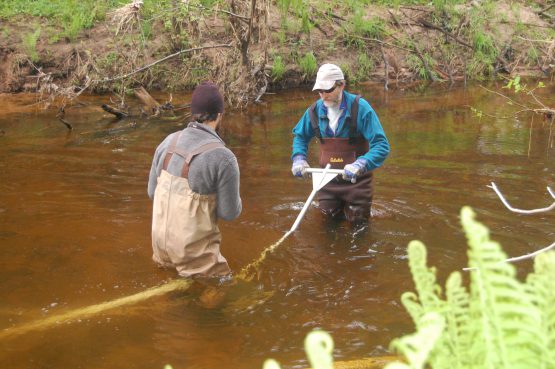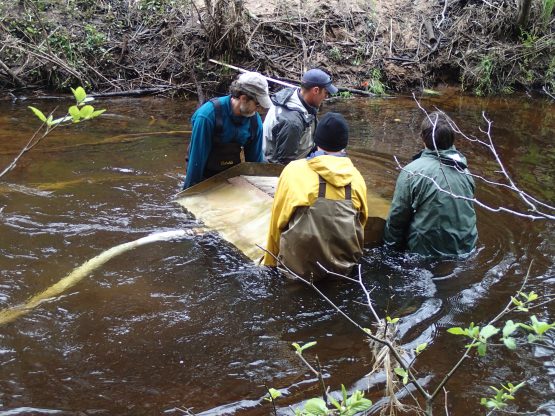Habitat Restoration – Salmon Trout River
A little background
Coaster brook trout were once common throughout Lake Superior basin tributaries and near shore waters, but the populations were wiped out due to over-fishing and habitat degradation. The Salmon Trout River, in Marquette, Mich., hosts the last known remnant breeding population of coasters in the area. Michigan Tech has been conducting long-term research on the status and ecology of this population since 2000. Based on annual assessments of coasters using stationary fish-counting weirs and visual counts of fish at spawning sites, the population appears to consist of only a few hundred adults that ascend the river each fall to spawn. Over the last decade, the Salmon Trout River has become degraded by land use and roads in the watershed causing erosion. Sand now covers the small section of stream-bottom cobbles where the majority of coasters once spawned, making the existing small population even more at risk of dying out. As sand continues to cover the cobbles and gravels where the coasters spawn, it also changes ecosystem dynamics; Michigan Tech has been examining these effects as the sands accumulate in the river so they can also study the beneficial effects of removing the sands.
The project
In an attempt to save the main spawning site, a Sediment Collector was installed to collect sediments and prevent bedload from moving downstream. Although the Collector was able to prevent sediment from moving downstream, a Sand Wand restoration was needed to remove the sediment build-up, that existed prior to the Collector installation, which still posed a big problem. Once the sand was cleared that covered the spawning site, the Collector was able to keep the site clean on its own, allowing coaster brook trout populations a better chance of recovery.
A little background
Coaster brook trout were once common throughout Lake Superior basin tributaries and near shore waters, but the populations were wiped out due to over-fishing and habitat degradation. The Salmon Trout River, in Marquette, Mich., hosts the last known remnant breeding population of coasters in the area. Michigan Tech has been conducting long-term research on the status and ecology of this population since 2000. Based on annual assessments of coasters using stationary fish-counting weirs and visual counts of fish at spawning sites, the population appears to consist of only a few hundred adults that ascend the river each fall to spawn. Over the last decade, the Salmon Trout River has become degraded by land use and roads in the watershed causing erosion. Sand now covers the small section of stream-bottom cobbles where the majority of coasters once spawned, making the existing small population even more at risk of dying out. As sand continues to cover the cobbles and gravels where the coasters spawn, it also changes ecosystem dynamics; Michigan Tech has been examining these effects as the sands accumulate in the river so they can also study the beneficial effects of removing the sands.
The project
In an attempt to save the main spawning site, a Sediment Collector was installed to collect sediments and prevent bedload from moving downstream. Although the Collector was able to prevent sediment from moving downstream, a Sand Wand restoration was needed to remove the sediment build-up, that existed prior to the Collector installation, which still posed a big problem. Once the sand was cleared that covered the spawning site, the Collector was able to keep the site clean on its own, allowing coaster brook trout populations a better chance of recovery.



